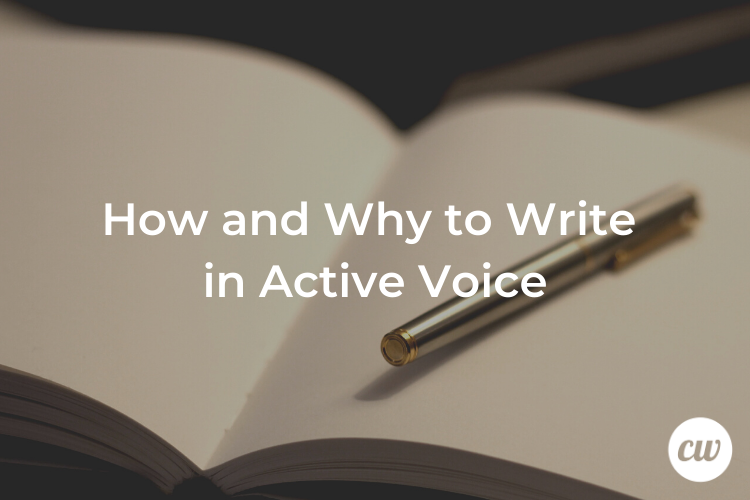
How to Write in Active Voice (& Why it Matters)
Looking to make your written content sparkle and shine with active voice?
Seasoned writers know that small details matter, and just rearranging a few words can make a big difference.
Grabbing the reader and capturing his or her attention means using verbs and active voice properly. This involves more than just getting the grammar right — writers must craft sentences in a way that keeps the flow and momentum moving forward.
In order to achieve the strongest possible content, professional writers prefer writing in active voice vs. passive voice in most instances.
Perhaps you’ve already heard of active voice and passive voice, but aren’t exactly sure how to approach those concepts in your own writing. We’ll clarify these techniques and provide examples below so you can start using active voice properly and create effective copy every time.
What Is Active Voice, and Why Is It Important?
When the subject of a sentence performs the action that’s expressed by the verb of that sentence, that’s an instance of using active voice. Moreover, the verb in that sentence is known as an active verb.
Here’s an example of using active voice:
- “The hungry boy ate the delicious hamburger in less than a minute.”
Pay special attention to the verb and its positioning in the sentence. Here, the subject is “boy” while the verb is “ate.”
Upon reading that sentence, one can imagine the ravenously hungry boy attacking that delicious hamburger. There’s forceful action and visual momentum in the sentence.
The subject (“boy”) is directly performing the action expressed by the verb (“ate”).
Now, we can rearrange and modify the same sentence, but this time we’ll use passive voice:
- “The delicious hamburger was eaten by the hungry boy in less than a minute.”
The same information is conveyed, but somehow the force and intent of the sentence aren’t quite as strong. By having the subject of the sentence (“hamburger”) acted upon by the verb (“eaten”), we’re conveying the same information but weakening the impact.
Here’s another example of a sentence using active voice:
- “With reckless abandon, Robert spent all the money at the casino.”
The quickest way to drain the power out of that sentence would be to use its passive-voice counterpart:
- “With reckless abandon, all the money was spent by Robert at the casino.”
The importance of using active voice is evident here: without it, the action is de-emphasized and the visual and emotional effect is diminished.
How to Approach Using Active Voice
Using active voice can make your sentences shorter, but that’s not necessarily a bad thing. Brevity can make your writing clearer and more direct.
Therefore, consider double-checking your sentences to make sure that the primary actor(s) of each sentence is (are) performing the main verb of that sentence.
To help you achieve this, here’s a simple tip:
- Look out for verbs like “is,” “are,” “was,” and “were” when they’re being used as helping verbs.
In some cases, these verbs are a sign that you’re using the easily-avoidable passive voice.
Here’s an example:
- “Four different books were read by the students during the summer break.”
In this instance, the “are” is a clear tip-off that there’s a passive-voice violation in progress. Let’s go ahead and convert this to active voice:
- “The students read four different books during the summer break.”
Don’t feel the need to force active voice into your writing. Instead, just get into the habit of placing the main doer of the action at or near the beginning of each sentence. That way, the rest of the sentence will naturally flow into an active-voice structure.
Adjusting Your Writing to Make It More Active
As you can see, it typically requires only minor adjustments to make your writing active instead of passive. Again, the key is to place the doer of the action at or near the beginning of the sentence, and before the verb.
Generally adhering to the formula of “subject, verb, object” can help you to get into the right habit.
For example:
- “The angry dog (subject) chased (verb) that fluffy cat (object).”
… is much better than:
- “That fluffy cat (object) was (there’s the telltale helping verb) chased (main verb) by the angry dog (subject).”
Is It Ever Acceptable to Use Passive Voice?
Now, we don’t want you to think that there’s no place for passive voice. There might be times when using passive voice is appropriate.
For instance, using passive voice can give writing a more literary tone:
- “I was absolutely driven to tears by that gauche, graceless rube,” pronounced the princess.
Additionally, if the subject or actor is unknown or irrelevant to the sentence, passive voice is acceptable.
- “The complaint was submitted on Monday afternoon.”
- “Gifts were left on the front steps of the shelter.”
In both the examples above, the question, “By whom?” can be asked, but not answered. In cases such as these, you can use passive voice.
Just be advised that counter-examples like this aren’t typical in content writing, particularly in practical contexts (such as writing used for marketing).
So, now it’s your turn – see how you can improve the flow, conciseness, impact, and overall tone of your writing with the mighty and underappreciated active voice.
David M, M.Ed has previously worked as a writing coach, editor, instructional and curriculum writer, and high school English teacher. He currently provides compelling content on behalf of InvestorPlace, Crush the Street, Market Realist, TalkMarkets, StockPence, Finom Group, and Benzinga. He also serves as the chief analyst and market researcher for Portfolio Wealth Global and hosts the popular financial YouTube channel Looking at the Markets.




